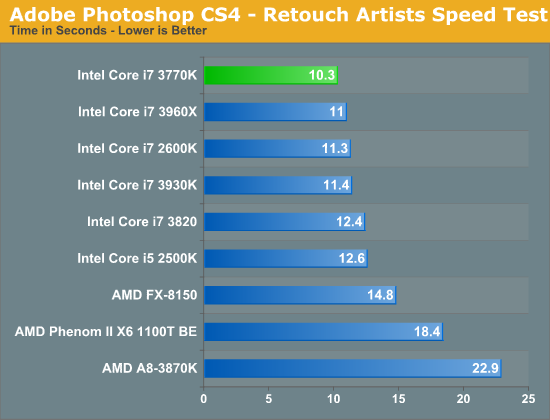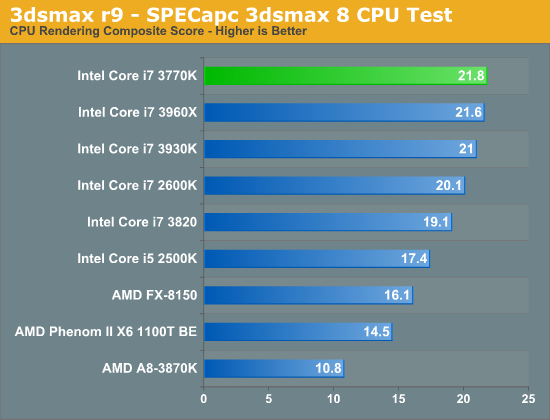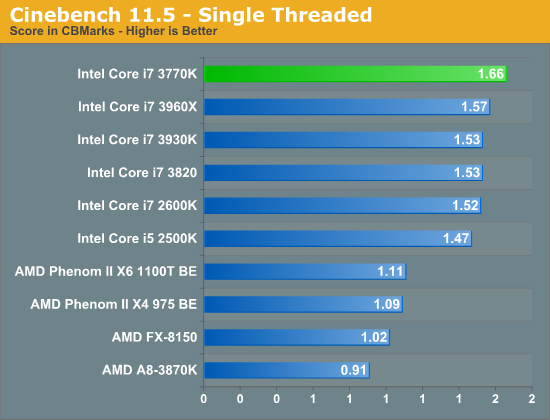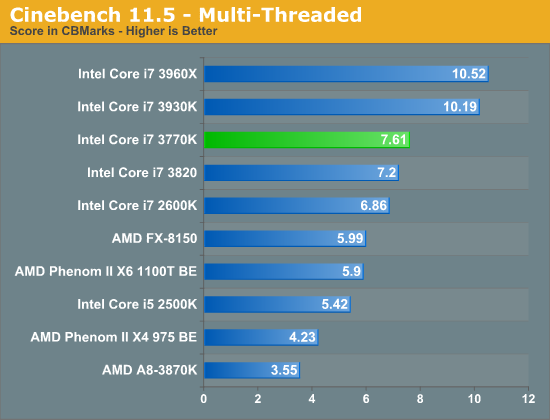The Ivy Bridge Preview: Core i7 3770K Tested
by Anand Lal Shimpi on March 6, 2012 8:16 PM EST- Posted in
- CPUs
- Intel
- Core i7
- Ivy Bridge
Content Creation Performance
Adobe Photoshop CS4
To measure performance under Photoshop CS4 we turn to the Retouch Artists’ Speed Test. The test does basic photo editing; there are a couple of color space conversions, many layer creations, color curve adjustment, image and canvas size adjustment, unsharp mask, and finally a gaussian blur performed on the entire image.
The whole process is timed and thanks to the use of Intel's X25-M SSD as our test bed hard drive, performance is far more predictable than back when we used to test on mechanical disks.
Time is reported in seconds and the lower numbers mean better performance. The test is multithreaded and can hit all four cores in a quad-core machine.

Our Photoshop test is well threaded but it doesn't peg all cores constantly. Instead you get burstier behavior. With the core count advantage out of the way, SNB-E steps aside and allows the 3770K to step up as the fastest CPU we've tested here. The performance advantage over the 2600K is around 9%.
3dsmax 9
Today's desktop processors are more than fast enough to do professional level 3D rendering at home. To look at performance under 3dsmax we ran the SPECapc 3dsmax 8 benchmark (only the CPU rendering tests) under 3dsmax 9 SP1. The results reported are the rendering composite scores.

In another FP heavy workload we see a pretty reasonable gain for Ivy Bridge: 8.5% over a 2600K. This isn't enough to make you want to abandon your Sandy Bridge, but it's a good step forward for a tick.
Cinebench 11.5
Created by the Cinema 4D folks we have Cinebench, a popular 3D rendering benchmark that gives us both single and multi-threaded 3D rendering results.

The single threaded Cinebench test shows a 9% performance advantage for the 3770K over the 2600K. The gap increases slightly to 11% as we look at the multithreaded results:

If you're running a workload that can really stress multiple cores, the 6-core Sandy Bridge E parts will remain unstoppable but in the quad-core world, Ivy Bridge leads the pack.










195 Comments
View All Comments
BoFox - Wednesday, March 7, 2012 - link
There are three different versions of HD 5570 (DDR2, DDR3, and GDDR5 - with the GDDR5 having FIVE times as much bandwidth as the DDR2 version).There are also two different versions of HD 5450 (DDR2 and DDR3).
It would be appreciated if you could let us know which versions were used in the benchmarks in this article. Thanks
BoFox - Wednesday, March 7, 2012 - link
Just let us know which GPU was used for the discrete GPU tests! LOL..KZ0 - Wednesday, March 7, 2012 - link
"ATI Radeon HD 5870 (Windows 7)", page 4:)
WiZARD7 - Wednesday, March 7, 2012 - link
There should be a comparison at the same clock speed - nehalem - sandy bridge - ivy bridge (@4 Ghz )Breach1337 - Wednesday, March 7, 2012 - link
On page, shouldn't:" Doing so won't give you access to some of the newer 7-series chipset features like PCIe Gen 3 (some 6-series boards are claiming 3.0 support), native USB 3.0 (many 6-series boards have 3rd party USB 3.0 controllers) and Intel's Rapid Start Technology."
say
" Doing so will give you access to some of the newer 7-series chipset features like PCIe Gen 3 (some 6-series boards are claiming 3.0 support), native USB 3.0 (many 6-series boards have 3rd party USB 3.0 controllers) and Intel's Rapid Start Technology."
iwod - Wednesday, March 7, 2012 - link
There are many thing not mentioned.Intel are strong in Software everywhere except the Gfx drivers department. No wonder why others call Anand a pro Intel site, i dont want to believe it, until all the article continue to label Intel are hard at work on Gfx drivers when they are clearly not. They are better then what they are used to be, but still far from good.
Graphics Quality on Intel IGP are not even close to what AMD offers.
Even if Haswell double the performance of Ivy they will still be one generation behind AMD.
I continue to wonder why they use their own GPU on Desktop / Laptop and not on Mobile SoC. They could have used PowerVR on Desktop as well, developing drivers for one hardware will simplify things and hopefully have bigger incentive to increase software R&D.
meloz - Wednesday, March 7, 2012 - link
>>No wonder why others call Anand a pro Intel siteWhat should he do, fake the benchmark results to make AMD look better than they are? Anand can only report his findings, he does this truthfully. Some people do not want to accept reality and prefer to shoot the messenger. Direct your frustrations towards AMD, not websites which report results of benchmarks.
From past benchmarks you can see the results at Anandtech are that different from other websites, AMD is getting destroyed on CPU perfomance and performance / watt metric.
>>I continue to wonder why they use their own GPU on Desktop / Laptop and not on Mobile SoC. They could have used PowerVR on Desktop as well,
FYI, they are dumping PowerVR in near future as well. Already covered on many websites, google it. PowerVR was a temporary fix, or rather an attempt at a fix which was more of a hassle and didn't work in the marketplace anyway.
They are now comitted to improving their own iGPU and drivers. This will take time for sure, Intel marches to its own beat.
The simple fact is that with the much weaker Sandy Brdige iGPU they outsold AMD 15 to 1, so even though the Ivy Bridge iGPU has not surpassed AMD yet, Intel should continue to do really well.
>>i dont want to believe it, until all the article continue to label Intel are hard at work on Gfx drivers when they are clearly not.
You can believe whatever you want to believe, this is not about beliefs but facts. As a user of Sandy Bridge and linux I know better than most just how much Intel drivers suck. In fact, their linux iGPU drivers suck much worse than Windows version (hard to imagine, but true) and weren't truly ready until Mesa 8.0, more than a year after release of the hardware.
But I also know they are working on things like SNA which in early test already offers ~20% performance boost.
No word on when it will be consumer ready, but Intel are working and steadily improving on drivers side as well. Perhaps not at the pace you want. You do not have to accept reality if it is so difficult for you, don't blame websites for reporting reality, however.
I am almost grateful Intel is not 'good enough' on GPU side as yet. It keeps AMD alive another year. Hopefully.
meloz - Wednesday, March 7, 2012 - link
>>From past benchmarks you can see the results at Anandtech are that different from other websitesShould read: From past benchmarks you can see the results at Anandtech are NOT that different from other websites.
Sigh, allow us to edit posts, if only for 10 minutes or so after making the initial post.
ET - Wednesday, March 7, 2012 - link
PowerVR has lower performance and fewer features, so would not be a good PC solution. I'm also sure that Intel would rather have its own solution, it's just that it can't yet compete with PowerVR at the low power arena. I imagine that if Intel succeeds in mobile space it will try to create its own low power 3D core.As for graphics drivers, I'm sure Intel is hard at work at them, but probably has fewer people than AMD on that. Far as I can see it's no longer the case that reviews with Intel graphics keep talking about what didn't run correctly, which means that things are getting better.
Belard - Wednesday, March 7, 2012 - link
Anyone notice in the Compile Chromium Test in which CORE count actually matters...AMD's "8 core" fx8150 doesn't come close to the 3770K, much less the 2500K (4 core/4 thread) CPU.
But give it to AMD for Llano for easily out-performing intel with built-in graphics, handy for notebooks. AMD should have put GPUs into the fx-line.
The odd-thing about intel's HD-Graphics is that the lower-end really needs to have the HD4000 more than the higher end.